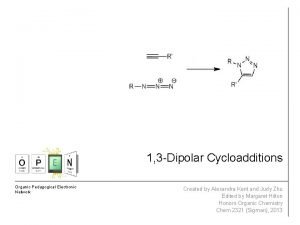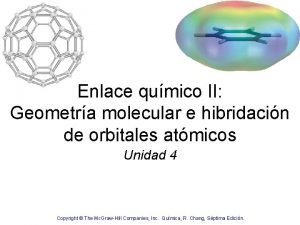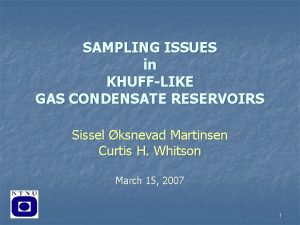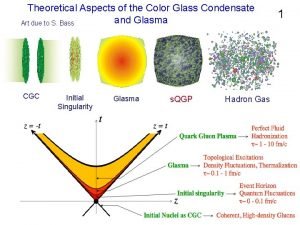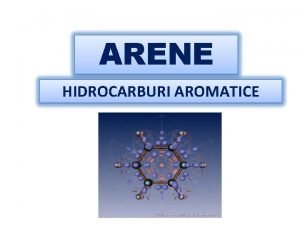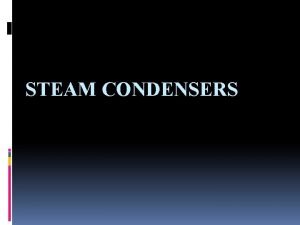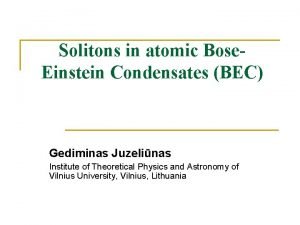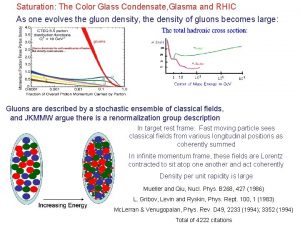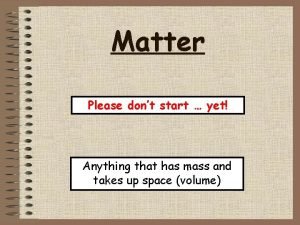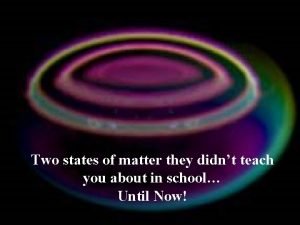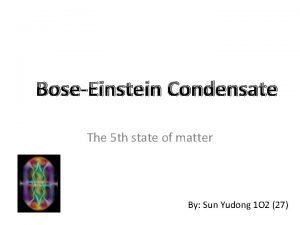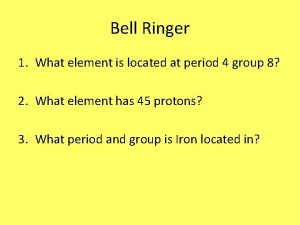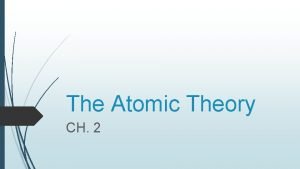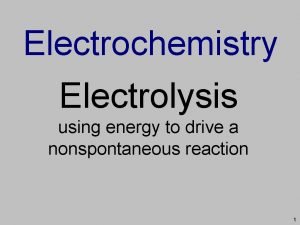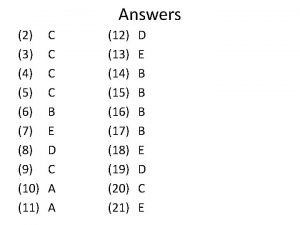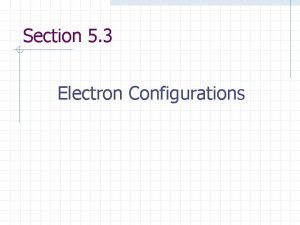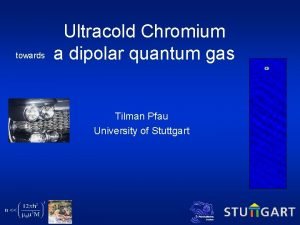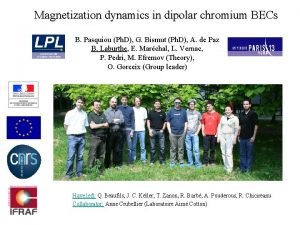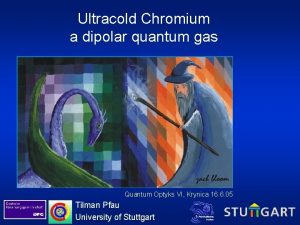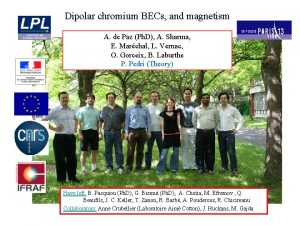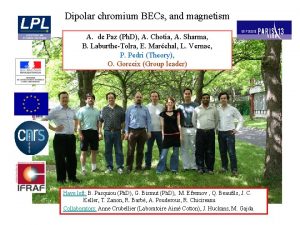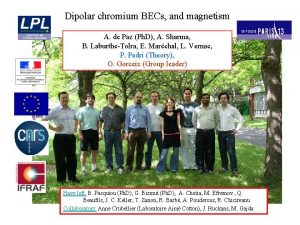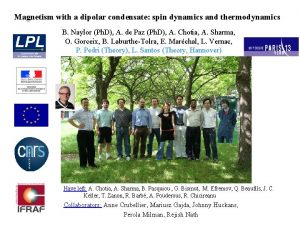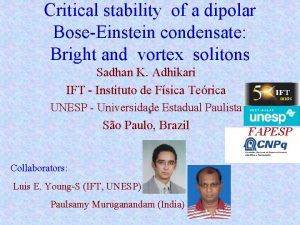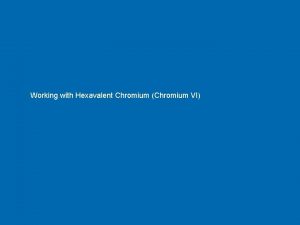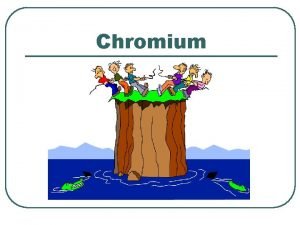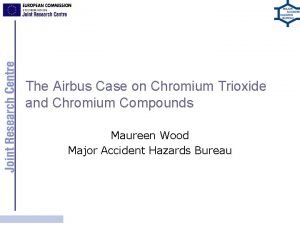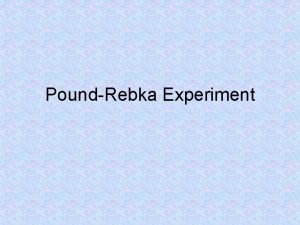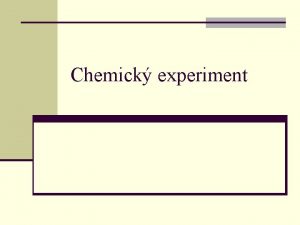Some experiment with of a chromium dipolar condensate





















- Slides: 21

Some experiment with of a chromium dipolar condensate A. de Paz (Ph. D), B. Naylor (Ph. D), A. Chotia, A. Sharma, O. Gorceix, E. Maréchal, L. Vernac, P. Pedri, B. Laburthe-Tolra Have left: A. Chotia, A. Sharma, B. Pasquiou , G. Bismut, M. Efremov, Q. Beaufils, J. C. Keller, T. Zanon, R. Barbé, A. Pouderous, R. Chicireanu Collaborators: Anne Crubellier, Luis Santos, Mariusz Gajda, Johnny Huckans, Perola Milman Rejish Nath

During this presentation : two recent experiments Quantum magnetism with Chromium atoms : Non equilibrium spin dynamics for DIPOLAR bosons that are loaded in a 3 D lattice Two chromium clouds loaded in a double well trap, interaction via Dipole interaction: A classical result.

Chromium : a dipolar BEC due to its large dipole (S=3) Dipole-dipole interactions Long range Anisotropic R Van-der-Waals (contact) interactions short range and isotropic Relative strength of dipole-dipole and Van-der-Waals interactions Chromium (S=3) Cr: (only few experiments worldwide with non-negligible dipolar interactions Others dipolar species : Er, Dy, Stuttgart, Innsbruck, Stanford, Boulder

Non equilibirum spin dynamics : sample preparation -We load a BEC in a deep 3 D rectangular lattice, S= 3, m=-3 - The loading is adiabatic and we reach a Mott state, with the “wedding cake” distribution: 2 atoms par site at the center= Doublons a shell with 1 atom per site = singlons The different Zeeman populations are measured by a Stern Gerlach separation

Non equilibrium spin dynamics : sample preparation -Then we can remove the doublons : simple initial situation, with only intersite interactions - Atoms, initially in m=-3 are prepared in -2 and the spin dynamic is monitored Vdd -2 -2 -3 -1 Heisenberg like hamiltonian (used in quantum magnetism): without spin changing term

Non equilibrium spin dynamics without doublons : E(ms) = q m. S 2 comparison with a plaquette model (Pedri, Santos) 3*3 sites , 8 sites containing one atom + 1 hole quadratic light shift and tunneling taken into account Evolution due to intersite Dipole Interations

Non equilibrium spin dynamics : is it interesting? Main originalities of this quantum system : - True many body system, and anisotropic system - Spin exchange term is due to true magnetic interaction - independent of tunneling - the super exchange term is not dominant Super exchange cartoon : J U J - Quantum magnetism with bosons - Three possible types of exchange : - Dipole dipole intactions - Contact Interactions - Superexchange if more tunneling

A mesoscopic system : two giants dipoles in a two well potential Initial motivations: direct observation of spin exchange with giant spins, « two body physics » , no contact interaction, simpler system with intersite interactions R N atoms -3 R = 4 µm Precession of one atom in the field create by Natoms Compensate 1/R^3 decrease by N increase R = 4 µm +3 N = 5000 Hz j=3 Hz N = 5000

Two giant dipoles in a two well potential : experimental details Two giant spins of ~104 µB Purely dipolar physics (seems a simpler system : contact interactions is factorize out) Long-period lattice Beams separated in a thermally-stable prism Phase stability 4. 1 µm In situ images The spin is selectively flipped for the left atoms in presence of a magnetic field gradient

Spin exchange dynamics in a double well trap: realization realizing a double well Long-period lattice Beams separated in a thermally-stable Non polarizing Lateral Beam splitter Phase stability

Spin exchange dynamics in a double well trap: first result But : almost no spin dynamics even if (Vdd =20 Hz) The magnetization is frozen.

Larger and larger spin: from quantum to classical magnetism. Observation of frozen spin dynamics S=1/2 -2 -3 Less and less quantum-ness -2 Right -1 Magnetization per atom S=3 S=104 Left Time (ms) Ising term Exchange term Interpretation: spin-exchange dynamics frozen by Ising term Beware of large spins ! 2 S+1 states Ising contribution gives different diagonal terms

Spin exchange dynamics in a double well trap: result -The slow evolution is due to contact interaction between the two clouds that are not fully separated - We could measure a 0 , the unknown scattering length in S=0 molecular channel for chromium. a 0 is negative, and our measurements give a 0=-100 a Bohr

Other results and futur work - Recent production of a Fermi see of 53 Cr - 1000 atoms, T/TF= 0, 6 (slightly degenerate) - Fermionic magnetism very different… - New experiment with strontium quantum gases - New lab, laser system, oven - Quantum magnetism using fermionic Sr in lattices Thank you!


short time scale : Spin exchange dynamics in a 3 D lattice with doublons (Contact interactions) -3 -2 -2 -1 On site contact interactions - |S=3, m=2>+|S=3, m=2> a|6, 6>Mol +b |6, 4>Mol -> a 6 and a 4 (60 nm ) G= ( 320 µs)

Contact Spin exchange dynamics from a double well trap after merging without merging Spin exchange dynamics due to contact interactions Fit of the data with theory gives an estimate of a 0 the unknown scattering length of chromium

Production of a degenerate quantum gas of fermionic chromium So many lasers… 7 P 4 53 Cr MOT : Trapping beams sketch 53 Cr MOT : laser frequencies production 7 S 3 Lock of Ti: Sa 2 is done with an ultrastable cavity

Production of a degenerate quantum gas of fermionic chromium Results In situ images Expansion analysis Nat parametric excitation of the trap frequencies Temperature slightly degenerated

Production of a degenerate quantum gas of fermionic chromium Evaporation

Production of a degenerate quantum gas of fermionic chromium What can we study with our gas? 9/2 7/2 5/2 Fermionic magnetism Phase separation 3 very different from bosonic magnetism ! 2 Picture at T= 0 and no interactions 0 -1/2 -3/2 -5/2 -7/2 -2 -3 1/2 1 -1 3/2 -9/2 Boltzmann Population in m. F=-9/2 requires good in situ imaging T=10 n. K T=50 n. K Fermi T=0 T=200 n. K minimize Etot Larmor frequency (k. Hz)
 Dipolar
Dipolar Dipolar bond
Dipolar bond Resultante
Resultante Como se calcula el momento dipolar
Como se calcula el momento dipolar Khuff condensate
Khuff condensate Gevift
Gevift In reactia de hidrogenare a naftalinei se utilizeaza
In reactia de hidrogenare a naftalinei se utilizeaza Condensate extraction pump working principle
Condensate extraction pump working principle Bose condensate theory
Bose condensate theory Pozitiile orto meta si para
Pozitiile orto meta si para Condensate blockage
Condensate blockage Color-glass condensate
Color-glass condensate Plasma and bose-einstein condensate
Plasma and bose-einstein condensate Extinguishion
Extinguishion Plasma and bose-einstein condensate
Plasma and bose-einstein condensate Bose einstein condensate definition chemistry
Bose einstein condensate definition chemistry How many protons does chromium-58 have
How many protons does chromium-58 have How many electrons are in the third energy level?
How many electrons are in the third energy level? What mass of chromium could be deposited by electrolysis
What mass of chromium could be deposited by electrolysis Copper subshell configuration
Copper subshell configuration Triphosphorus pentasulfide
Triphosphorus pentasulfide Aufbau principle
Aufbau principle
